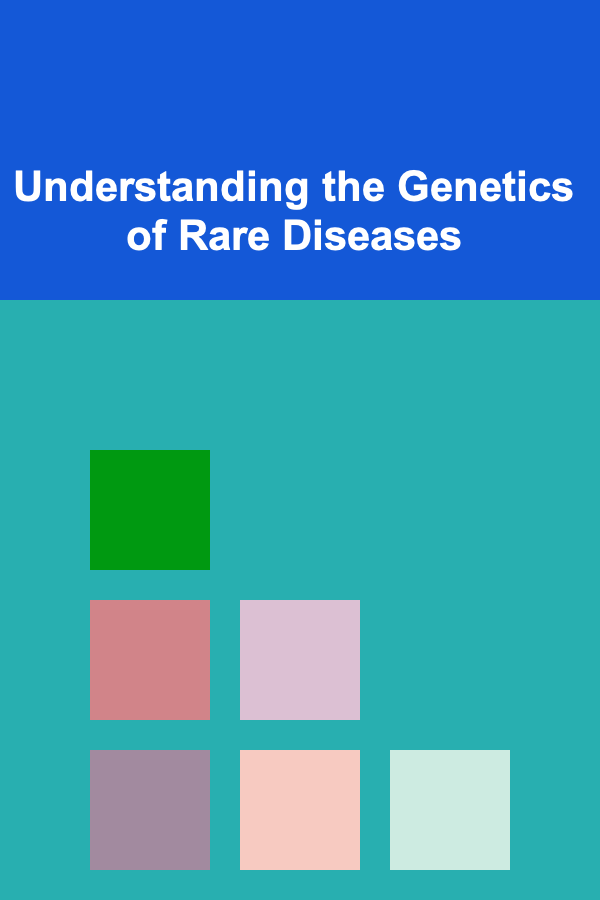
Understanding the Genetics of Rare Diseases
ebook include PDF & Audio bundle (Micro Guide)
$12.99$9.99
Limited Time Offer! Order within the next:

Rare diseases, by definition, affect a relatively small percentage of the population, but collectively, they impact a significant number of individuals worldwide. Understanding the genetic basis of these conditions is crucial for accurate diagnosis, improved treatment strategies, and ultimately, prevention. This article provides a comprehensive overview of the genetics of rare diseases, exploring the underlying mechanisms, diagnostic approaches, and the challenges and opportunities in this rapidly evolving field.
What are Rare Diseases?
A rare disease is generally defined as a condition that affects a small number of people compared to the general population. The exact definition varies between countries and regions. In the United States, a rare disease is defined as one that affects fewer than 200,000 people. In the European Union, a disease is considered rare if it affects no more than 1 in 2,000 people. While each individual rare disease may affect only a small number of people, there are thousands of different rare diseases, affecting millions of individuals and families globally. These diseases can be chronic, progressive, debilitating, and often life-threatening.
Many rare diseases are genetic, meaning they are caused by alterations in an individual's DNA. However, some rare diseases are caused by infections, environmental factors, or are of unknown origin. Due to their rarity and complexity, diagnosing rare diseases can be a lengthy and challenging process, often involving a "diagnostic odyssey" where patients see multiple specialists and undergo numerous tests before receiving an accurate diagnosis.
The Genetic Basis of Rare Diseases
The majority of rare diseases have a genetic component, meaning that changes in genes or chromosomes are the primary cause of the disease. These genetic alterations can range from single nucleotide variations (SNVs) to large-scale chromosomal abnormalities. Understanding the specific genetic mutation responsible for a rare disease is critical for several reasons:
- Accurate Diagnosis: Genetic testing can confirm a clinical diagnosis and differentiate between similar rare diseases.
- Prognosis: Knowing the specific mutation can sometimes provide information about the expected course and severity of the disease.
- Genetic Counseling: Genetic testing allows for informed genetic counseling, enabling families to understand the risk of recurrence in future pregnancies.
- Personalized Treatment: With the advent of precision medicine, identifying the underlying genetic cause can lead to targeted therapies that address the specific molecular defect.
Types of Genetic Mutations
Several types of genetic mutations can cause rare diseases:
- Single Nucleotide Variations (SNVs): These are the most common type of genetic variation, involving a change in a single nucleotide base (A, T, C, or G) in the DNA sequence. SNVs can be further classified as:
- Missense mutations: A single base change that results in the substitution of one amino acid for another in the protein sequence. This can alter the protein's structure and function.
- Nonsense mutations: A single base change that introduces a premature stop codon, resulting in a truncated and often non-functional protein.
- Silent mutations: A single base change that does not alter the amino acid sequence due to the redundancy of the genetic code. However, some silent mutations can affect splicing or mRNA stability.
- Insertions and Deletions (Indels): These mutations involve the addition or removal of one or more nucleotides from the DNA sequence. If the number of inserted or deleted nucleotides is not a multiple of three, it can cause a frameshift mutation.
- Frameshift Mutations: Indels that are not multiples of three shift the reading frame of the genetic code, leading to a completely different amino acid sequence downstream of the mutation. This usually results in a non-functional protein.
- Splice Site Mutations: These mutations affect the splicing process, where non-coding regions (introns) are removed from the pre-mRNA molecule. Splice site mutations can lead to abnormal splicing, resulting in the inclusion of introns or the exclusion of exons, which can disrupt protein function.
- Copy Number Variations (CNVs): CNVs involve the deletion or duplication of large segments of DNA, ranging from a few kilobases to several megabases. CNVs can affect the dosage of multiple genes, leading to developmental disorders and other rare diseases.
- Chromosomal Abnormalities: These are large-scale changes in chromosome structure or number. Examples include:
- Trisomy: The presence of an extra copy of a chromosome (e.g., Trisomy 21 in Down syndrome).
- Monosomy: The absence of one copy of a chromosome (e.g., Turner syndrome).
- Translocations: The transfer of a segment of one chromosome to another.
- Deletions: The loss of a portion of a chromosome.
- Duplications: The presence of an extra copy of a portion of a chromosome.
- Repeat Expansions: These mutations involve the amplification of short DNA sequences, such as trinucleotide repeats. When the number of repeats exceeds a certain threshold, it can lead to neurodegenerative disorders like Huntington's disease and Fragile X syndrome.
- Mitochondrial Mutations: Mutations in mitochondrial DNA (mtDNA) can cause mitochondrial disorders, which affect the energy production in cells. Mitochondrial disorders often affect multiple organ systems and can present with a wide range of symptoms.
Inheritance Patterns of Rare Diseases
Understanding the inheritance pattern of a rare disease is crucial for assessing the risk of recurrence in families and for providing accurate genetic counseling. The major inheritance patterns include:
- Autosomal Dominant Inheritance: In autosomal dominant inheritance, only one copy of the mutated gene is sufficient to cause the disease. Affected individuals usually have at least one affected parent. Each child of an affected individual has a 50% chance of inheriting the mutated gene and developing the disease. Examples include Huntington's disease and Marfan syndrome.
- Autosomal Recessive Inheritance: In autosomal recessive inheritance, two copies of the mutated gene are required to cause the disease. Affected individuals usually have unaffected parents who are carriers of the mutated gene. Each child of two carrier parents has a 25% chance of inheriting both mutated genes and developing the disease, a 50% chance of being a carrier, and a 25% chance of inheriting two normal genes. Examples include cystic fibrosis and sickle cell anemia.
- X-Linked Dominant Inheritance: In X-linked dominant inheritance, the mutated gene is located on the X chromosome, and only one copy of the mutated gene is sufficient to cause the disease. Affected males will pass the mutation to all of their daughters and none of their sons. Affected females have a 50% chance of passing the mutation to each of their children, regardless of sex. Examples include Rett syndrome (typically lethal in males) and Fragile X syndrome (in some cases).
- X-Linked Recessive Inheritance: In X-linked recessive inheritance, the mutated gene is located on the X chromosome, and two copies of the mutated gene are required to cause the disease in females. Males, who have only one X chromosome, will be affected if they inherit one copy of the mutated gene. Unaffected female carriers have a 50% chance of passing the mutation to each of their sons, who will be affected, and a 50% chance of passing the mutation to each of their daughters, who will be carriers. Affected males will pass the mutation to all of their daughters, who will be carriers, and none of their sons. Examples include hemophilia and Duchenne muscular dystrophy.
- Mitochondrial Inheritance: Mitochondrial disorders are caused by mutations in mtDNA, which is inherited solely from the mother. All children of an affected mother will inherit the mutated mtDNA, but the severity of the disease can vary depending on the proportion of mutated mtDNA molecules in each cell (heteroplasmy). Fathers do not pass on mitochondrial DNA.
- De Novo Mutations: In some cases, a rare disease is caused by a de novo mutation, meaning that the mutation arose spontaneously in the egg or sperm cell of one of the parents, or early in embryonic development. In these cases, the parents are not carriers of the mutation, and the risk of recurrence in future pregnancies is typically very low (although germline mosaicism, where a portion of a parent's germ cells carries the mutation, can increase the recurrence risk).
It's important to note that some rare diseases can have complex inheritance patterns, involving multiple genes (polygenic inheritance) or gene-environment interactions. In these cases, determining the exact genetic cause and assessing the risk of recurrence can be more challenging.
Diagnostic Approaches for Rare Genetic Diseases
The diagnosis of rare genetic diseases can be a complex and challenging process, often requiring a multidisciplinary approach. Several diagnostic tools are available, including:
Clinical Evaluation
A thorough clinical evaluation is the first step in diagnosing a rare disease. This involves a detailed medical history, a physical examination, and assessment of the patient's symptoms and signs. The clinical evaluation can help to narrow down the list of possible diagnoses and guide the selection of appropriate genetic tests.
Family History
Obtaining a detailed family history is crucial for identifying potential inheritance patterns and assessing the risk of recurrence. The family history should include information about affected and unaffected individuals, as well as any consanguinity (blood relationship) between the parents.
Genetic Testing
Genetic testing plays a central role in the diagnosis of rare genetic diseases. Several types of genetic tests are available, each with its own advantages and limitations:
- Karyotyping: Karyotyping involves examining the chromosomes under a microscope to identify large-scale chromosomal abnormalities, such as trisomies, monosomies, translocations, and deletions.
- Chromosomal Microarray Analysis (CMA): CMA is a technique that detects CNVs throughout the genome. CMA has largely replaced karyotyping as the first-tier test for developmental delay and intellectual disability.
- Single-Gene Testing: If the clinical features suggest a specific rare disease, single-gene testing can be performed to look for mutations in the gene known to be associated with that disease. This involves sequencing the gene using Sanger sequencing or next-generation sequencing (NGS).
- Gene Panels: Gene panels involve sequencing a targeted set of genes that are known to be associated with a specific clinical phenotype. This approach is more efficient and cost-effective than sequencing individual genes one at a time.
- Exome Sequencing (ES): ES involves sequencing all of the protein-coding regions (exons) of the genome. This approach can identify mutations in genes that are not included in gene panels. ES is often used as a diagnostic tool for patients with complex or undiagnosed rare diseases.
- Genome Sequencing (GS): GS involves sequencing the entire genome, including both the coding and non-coding regions. GS can identify mutations that are not detected by ES, such as mutations in regulatory regions or deep intronic mutations that affect splicing.
- Mitochondrial DNA Sequencing: Mitochondrial DNA sequencing is used to detect mutations in mtDNA, which can cause mitochondrial disorders.
- Biochemical Testing: Biochemical testing involves measuring the levels of specific metabolites or enzymes in blood, urine, or other tissues. This can help to diagnose metabolic disorders, which are often caused by genetic mutations that affect enzyme function.
Other Diagnostic Tests
In addition to genetic and biochemical testing, other diagnostic tests may be used to evaluate patients with suspected rare diseases, including:
- Imaging Studies: Imaging studies, such as X-rays, CT scans, MRI scans, and ultrasounds, can help to identify structural abnormalities or organ dysfunction.
- Electrophysiological Studies: Electrophysiological studies, such as electroencephalography (EEG) and electromyography (EMG), can help to assess the function of the brain and nerves.
- Muscle Biopsy: A muscle biopsy involves taking a small sample of muscle tissue for microscopic examination. This can help to diagnose neuromuscular disorders.
- Skin Biopsy: A skin biopsy involves taking a small sample of skin tissue for microscopic examination. This can help to diagnose certain genetic skin disorders.
Challenges in Understanding the Genetics of Rare Diseases
Despite significant advances in genetic technology, understanding the genetics of rare diseases remains a complex and challenging endeavor. Some of the major challenges include:
- Rarity of the Diseases: The rarity of these conditions makes it difficult to collect enough data to identify the underlying genetic causes and to conduct clinical trials to evaluate potential treatments.
- Genetic Heterogeneity: Many rare diseases are genetically heterogeneous, meaning that they can be caused by mutations in different genes. This makes it more difficult to identify the causative gene in a given patient.
- Phenotypic Variability: The same genetic mutation can sometimes cause a wide range of symptoms and severity (phenotypic variability). This makes it difficult to establish a clear genotype-phenotype correlation.
- Variant Interpretation: A significant challenge lies in interpreting the vast number of genetic variants identified by NGS. Distinguishing between pathogenic variants (disease-causing) and benign variants (harmless) can be difficult, especially for variants that have not been previously reported. This often requires careful analysis of the variant's location in the gene, its predicted effect on protein function, its frequency in the general population, and its co-segregation with the disease in affected families.
- Lack of Animal Models: Animal models are essential for studying the pathogenesis of diseases and for testing potential therapies. However, it can be difficult to develop animal models that accurately replicate the human disease phenotype for many rare diseases.
- Diagnostic Odyssey: Patients with rare diseases often face a lengthy and frustrating "diagnostic odyssey," involving multiple consultations with specialists and a battery of tests before receiving an accurate diagnosis. This can lead to significant delays in treatment and increased healthcare costs.
- Ethical Considerations: Genetic testing raises a number of ethical considerations, including issues related to privacy, confidentiality, and the potential for genetic discrimination. It is important to ensure that patients are fully informed about the risks and benefits of genetic testing before making a decision.
Opportunities and Future Directions
Despite the challenges, there are also many opportunities to advance our understanding of the genetics of rare diseases and to improve the lives of patients and families affected by these conditions. Some of the promising areas of research and development include:
- Expanded Newborn Screening: Expanding newborn screening programs to include more rare genetic diseases can lead to earlier diagnosis and treatment, potentially preventing or mitigating the long-term consequences of these conditions.
- Improved Diagnostic Technologies: The development of new and improved diagnostic technologies, such as long-read sequencing and RNA sequencing, can help to identify the underlying genetic causes of rare diseases more quickly and accurately.
- Functional Genomics: Functional genomics approaches, such as CRISPR-Cas9 gene editing and induced pluripotent stem cells (iPSCs), can be used to study the function of genes and to model the effects of genetic mutations in vitro.
- Drug Repurposing: Drug repurposing involves identifying existing drugs that can be used to treat rare diseases. This approach can accelerate the development of new therapies, as the safety and efficacy of the drugs have already been established.
- Gene Therapy: Gene therapy involves delivering a functional copy of a mutated gene to cells to correct the underlying genetic defect. Gene therapy holds great promise for treating a variety of rare genetic diseases.
- Personalized Medicine: Personalized medicine involves tailoring treatment to the individual patient based on their genetic profile and other factors. This approach can lead to more effective and targeted therapies for rare diseases.
- International Collaboration: International collaboration is essential for accelerating the discovery and development of new treatments for rare diseases. Sharing data, resources, and expertise can help to overcome the challenges posed by the rarity of these conditions.
- Patient Advocacy Groups: Patient advocacy groups play a crucial role in raising awareness of rare diseases, supporting research, and advocating for policies that benefit patients and families.
Conclusion
Understanding the genetics of rare diseases is a complex but crucial endeavor. While challenges remain, advances in genetic technologies, coupled with international collaboration and patient advocacy, are paving the way for improved diagnostics, targeted therapies, and ultimately, a better quality of life for individuals and families affected by these conditions. Continued research and innovation are essential to unlock the mysteries of rare diseases and to translate scientific discoveries into meaningful clinical benefits.

How to Use Resume Writing Services to Make Money
Read More
Start Here: The Basics of Photography
Read More
Why Organizing Your Closet by Season Simplifies Outfit Choices
Read More
How To Design a Bathroom Oasis
Read More
How To Find Affordable Healthcare Options
Read More
How to Budget for Your Travel Bucket List: A Realistic Planner
Read MoreOther Products

How to Use Resume Writing Services to Make Money
Read More
Start Here: The Basics of Photography
Read More
Why Organizing Your Closet by Season Simplifies Outfit Choices
Read More
How To Design a Bathroom Oasis
Read More
How To Find Affordable Healthcare Options
Read More